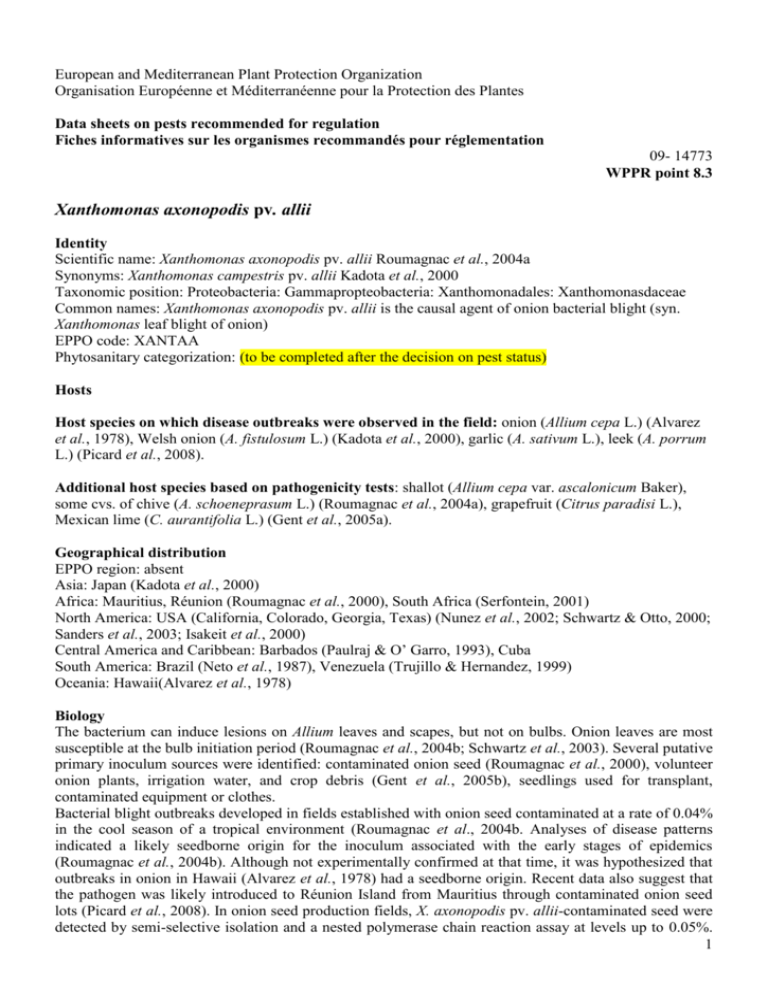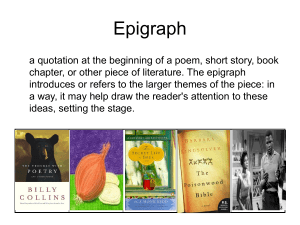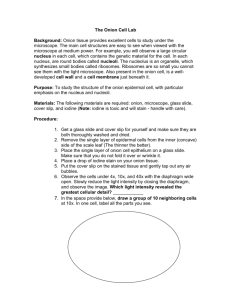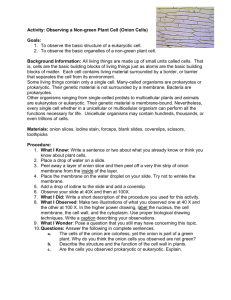09-14773
advertisement

European and Mediterranean Plant Protection Organization Organisation Européenne et Méditerranéenne pour la Protection des Plantes Data sheets on pests recommended for regulation Fiches informatives sur les organismes recommandés pour réglementation 09- 14773 WPPR point 8.3 Xanthomonas axonopodis pv. allii Identity Scientific name: Xanthomonas axonopodis pv. allii Roumagnac et al., 2004a Synonyms: Xanthomonas campestris pv. allii Kadota et al., 2000 Taxonomic position: Proteobacteria: Gammapropteobacteria: Xanthomonadales: Xanthomonasdaceae Common names: Xanthomonas axonopodis pv. allii is the causal agent of onion bacterial blight (syn. Xanthomonas leaf blight of onion) EPPO code: XANTAA Phytosanitary categorization: (to be completed after the decision on pest status) Hosts Host species on which disease outbreaks were observed in the field: onion (Allium cepa L.) (Alvarez et al., 1978), Welsh onion (A. fistulosum L.) (Kadota et al., 2000), garlic (A. sativum L.), leek (A. porrum L.) (Picard et al., 2008). Additional host species based on pathogenicity tests: shallot (Allium cepa var. ascalonicum Baker), some cvs. of chive (A. schoeneprasum L.) (Roumagnac et al., 2004a), grapefruit (Citrus paradisi L.), Mexican lime (C. aurantifolia L.) (Gent et al., 2005a). Geographical distribution EPPO region: absent Asia: Japan (Kadota et al., 2000) Africa: Mauritius, Réunion (Roumagnac et al., 2000), South Africa (Serfontein, 2001) North America: USA (California, Colorado, Georgia, Texas) (Nunez et al., 2002; Schwartz & Otto, 2000; Sanders et al., 2003; Isakeit et al., 2000) Central America and Caribbean: Barbados (Paulraj & O’ Garro, 1993), Cuba South America: Brazil (Neto et al., 1987), Venezuela (Trujillo & Hernandez, 1999) Oceania: Hawaii(Alvarez et al., 1978) Biology The bacterium can induce lesions on Allium leaves and scapes, but not on bulbs. Onion leaves are most susceptible at the bulb initiation period (Roumagnac et al., 2004b; Schwartz et al., 2003). Several putative primary inoculum sources were identified: contaminated onion seed (Roumagnac et al., 2000), volunteer onion plants, irrigation water, and crop debris (Gent et al., 2005b), seedlings used for transplant, contaminated equipment or clothes. Bacterial blight outbreaks developed in fields established with onion seed contaminated at a rate of 0.04% in the cool season of a tropical environment (Roumagnac et al., 2004b. Analyses of disease patterns indicated a likely seedborne origin for the inoculum associated with the early stages of epidemics (Roumagnac et al., 2004b). Although not experimentally confirmed at that time, it was hypothesized that outbreaks in onion in Hawaii (Alvarez et al., 1978) had a seedborne origin. Recent data also suggest that the pathogen was likely introduced to Réunion Island from Mauritius through contaminated onion seed lots (Picard et al., 2008). In onion seed production fields, X. axonopodis pv. allii-contaminated seed were detected by semi-selective isolation and a nested polymerase chain reaction assay at levels up to 0.05%. 1 The final disease incidence was 0.61. Contaminated seed originated from both diseased and asymptomatic plants (Humeau et al., 2006). X. axonopodis pv. allii can survive and retain some culturability for at least ten years in association with onion seed stored in a cool place (4 °C) (Robene-Soustrade, unpublished data). X. axonopodis pv. allii was not recovered from plants other than Allium in experimental sites in Colorado where an epidemic of Xanthomonas leaf blight did not occur the prior year (Gent et al., 2005b; Gent et al., 2005c) although was recovered from the foliage of several asymptomatic cultivated (alfalfa, chickpea, dry bean, lentil, and soybean) and weed (Malva neglecta) species. In northern and southern Colorado X. axonopodis pv. allii was recovered from infested onion leaves nine months after they were placed on the soil surface or buried to a depth of 25 cm, but culturable populations of the pathogen decreased 104 to 106 more in buried leaves (Gent et al., 2005b). Disease development in onion is favoured by warm temperatures (Schwartz et al., 2003), but daily mean temperatures as low as 21-22°C allowed disease development in field trials established in Réunion Island (Roumagnac et al., 2004b; Humeau et al., 2006). Over three years, disease development in Réunion Island was observed to be related to a succession of two climatic events, heavy rains followed by temperatures exceeding 20°C (Roumagnac et al., 2004b). As for many xanthomonads, the length of the latent infection period depends on temperature. Fitting the β-binomial distribution and binary power law analysis indicated aggregated patterns of disease incidence data from onion bulb and onion seed production fields. Secondary foci were detected after occurrence of wind-driven rains confirming the importance of such environmental conditions in bacterial spread (Roumagnac et al., 2004b; Humeau et al., 2006). Overhead irrigation (Roumagnac et al., 2004) or extensive nitrogen fertilization (Gent & Schwartz, 2005) exacerbated disease development. Detection and identification Symptoms On onion, lesions consist of lenticular water-soaked leaf spots which turn into dry chlorotic lesions that eventually coalesce. When disease is severe, leaf dieback can occur, resulting in a reduction of bulb size. The morphology of leaf lesions on other Allium species is similar to those on onion (Picard et al., 2008). X. axonopodis pv. allii was also pathogenic to Mexican lime and grapefruit after bacterial infiltration, and produced lesions that were similar to citrus bacterial spot (i.e. water-soaked leaf lesions turning into necrotic spots) (Gent et al., 2005a). Host specialization among strains remains largely unknown. However, no host specialization was evidenced on strains collected in Réunion Island and originating from outbreaks on onion, leek and garlic, respectively, which could all infect the same range of Allium species when tested (Picard et al., 2008). Identification Identification currently requires the availability of bacterial pure cultures. This is facilitated by the availability of semi-selective media (Roumagnac et al., 2000; Gent & Schwartz, 2005b). Identification at the genus level can be achieved through sequencing of 16S rDNA (Moore et al., 1997) or characterization of xanthomonadin pigments (Schaad, 1988). Formal identification at the pathovar level requires fulfilment of Koch’s postulates, although molecular typing techniques such as rep-PCR and AFLP (Gent et al., 2004; Roumagnac et al., 2004a; Humeau et al., 2006) can be used for preliminary screening of strains to be inoculated. A multiplex PCR protocol usable on seed macerates without any culture step is currently Pathway for movement The most important pathway for long distance movement of the pathogen is Allium seeds . The pathogen may be spread long-distance through infected Allium seedlings used for transplant, but no documented case is known. The pest is locally spread by wind-driven rains, irrigation water, humans, and contaminated tools, equipment used in crop management and possibly contaminated animals, although this has not been demonstrated. Pest significance Economic impact 2 Infection of the aerial parts of onion by the pathogen may lead to a reduction in bulb size. Yield losses for onion bulbs ranging from 10 to 50% were reported in the continental United States (Nunez et al., 2002; Schwartz & Otto, 2000; Sanders et al., 2003). Although not precisely documented, the impact of the disease may be larger in tropical countries. Data from Barbados indicate cases where an entire onion crop loss was observed (O’ Garro & Paulraj, 1997). Severe reductions in onion bulb size were recorded in South Africa (Serfontein, 2001). Control Control in the US is most often partially achieved through a massive use of copper bactericides sometimes amended with ethylenebisdithiocarbamate fungicides, but this strategy is economically and environmentally not satisfactory (Gent & Schwartz, 2005a). Alternative management programs involving plant activators (acibenzolar-S-methyl), bacteriophages or antagonistic bacteria are being developed experimentally (Gent & Schwartz, 2005a; Lang et al., 2007). However, these new management programmes are not currently as affordable as conventional programs which also protect onion against other diseases (Lang et al., 2007). Seed health testing should also be developed (Picard et al., 2008). Prophylactic measures usually implemented for the control of plant pathogenic bacteria should be used. Although not experimentally evaluated, the host range of X. axonopodis pv. allii suggests that crop rotation should be considered in IPM programmes. However, the longevity of the pathogen’s survival in the field in association with crop debris or in the absence of Allium spp. and weeds is not precisely known. Overhead irrigation should be avoided (Roumagnac et al., 2004b) and furrow or drip irrigation should be considered as alternative irrigation modes. No Allium cultivar has been consistently characterized as resistant to X. axonopodis pv. allii and no source of resistance has been identified to date. Phytosanitary risk Xanthomonas axonopodis pv. allii can cause significant yield losses and high costs for chemical control (ca. €200 per ha) (Lang et al., 2007) when conditions are suitable. This pest presents a risk for Allium spp. grown outdoors in the Mediterranean parts of the EPPO region and to a lesser extent the temperate parts of the EPPO region. Phytosanitary measures TO BE COMPLETED WHEN RECOMMENDATIONS ON THE MEASURES WILL BE AGREED. Bibliography Alvarez AM, Buddenhagen IW, Buddenhagen ES & Domen HY (1978) Bacterial blight of onion, a new disease caused by Xanthomonas sp. Phytopathology 68: 1132-1136. Gent DH, Al-Saadi A, Gabriel DW, Louws FJ, Ishimaru CA & Schwartz HF (2005a) Pathogenic and genetic relatedness among Xanthomonas axonopodis pv. allii and other pathovars of X. axonopodis. Phytopathology 95: 918-925. Gent DH, Lang JM, Bartolo ME & Schwartz HR (2005b) Inoculum sources and survival of Xanthomonas axonopodis pv. allii in Colorado. Plant Dis 89: 507-514. Gent DH, Lang JM & Schwartz HF (2005c) Epiphytic survival of Xanthomonas axonopodis pv. allii and X. axonopodis pv. phaseoli on leguminous hosts and onion. Plant Dis 89: 558-564. Gent DH & Schwartz HF (2005a) Management of Xanthomonas leaf blight of onion with a plant activator, biological control agents, and copper bactericides. Plant Dis 89: 631-639. Gent DH & Schwartz HF (2005b) Effect of nitrogen fertilization and seed contamination on epiphytic populations of Xanthomonas axonopodis pv. allii and development of Xanthomonas leaf blight of onion. Plant Health Prog. Gent DH, Schwartz HF, Ishimaru CA, Louws FJ, Cramer RA & Lawrence CB (2004) Polyphasic characterization of Xanthomonas strains from onion. Phytopathology 94: 184-195. Humeau L, Roumagnac P, Picard Y, Robène-Soustrade I, Chiroleu F, Gagnevin L & Pruvost O (2006) Quantitative and molecular epidemiology of bacterial blight of onion in seed production fields. Phytopathology 96: 1345-1354. Isakeit T, Miller ME, Barnes LW, Dickstein ER & Jones JB (2000) First report of leaf blight of onion 3 caused by Xanthomonas campestris in the Continental United States. Plant Dis 84: 201. Kadota I, Uehara K, Shinohara H & Nishiyama K (2000) Bacterial blight of Welsh onion : A new disease caused by Xanthomonas campestris pv. allii pv. nov. Journal of General Plant Pathology 66: 310315. Lang JM, Gent DH & Schwartz HF (2007) Management of Xanthomonas leaf blight of onion with bacteriophages and a plant activator. Plant Dis 91: 871-878. Moore ERB, Kruger AS, Hauben L, Seal SE, De Baere R, De Wachter R, Timmis KN & Swings J (1997) 16S rRNA gene sequence analyses and inter- and intrageneric relationships of Xanthomonas species and Stenotrophomonas maltophilia. FEMS Microbiol. Letters 151: 145-153. Neto JR, Malavolta Jr. VA, Cardelli MA & Sinigaglia C (1987) Ocorrencia de uma nova doença bacteriana em cebola, no estado de Sao Paulo. Summa Phytopathol. 13: 10. Nunez JJ, Gilbertson RL, Meng X & Davis RM (2002) First report of Xanthomonas leaf blight of onion in California. Plant Dis 86: 330. Paulraj L & O' Garro LW (1993) Leaf blight of onions in Barbados caused by Xanthomonas campestris. Plant Dis 77: 198-201. Picard Y, Roumagnac P, Legrand D, Humeau L, Robène-Soustrade I, Chiroleu F, Gagnevin L & Pruvost O (2008) Polyphasic characterization of Xanthomonas axonopodis pv. allii associated with outbreaks of bacterial blight on three Allium species in the Mascarene archipelago. Phytopathology 98: 919-925. Robene-Soustrade I, Legrand, D, Couteau A, Humeau L, Roux-Cuvelier M, Roumagnac, P & Pruvost , O (2005) A nested PCR-multiplex to detect Xanthomonas axonopodis pv. allii in onion seeds. In 5th ISTA-SHC Seed Health Symposium Angers France: International Seed Testing Association. Roumagnac P, Gagnevin L, Gardan L, Sutra L, Manceau C, Dickstein ER, Jones JB, Rott P & Pruvost O (2004a) Polyphasic characterization of xanthomonads isolated from onion, garlic and Welsh onion (Allium spp.) and their relatedness to different Xanthomonas species. Int J Syst Evol Microbiol 54: 15-24. Roumagnac P, Gagnevin L & Pruvost O (2000) Detection of Xanthomonas sp., the causal agent of onion bacterial blight, in onion seeds using a newly developed semi-selective isolation medium. Eur J Plant Pathol 106: 867-877. Roumagnac P, Pruvost O, Chiroleu F & Hughes G (2004b) Spatial and temporal analyses of bacterial blight of onion caused by Xanthomonas axonopodis pv. allii. Phytopathology 94: 138-146. Sanders FH, Langston Jr. DB, Brock JH, Gitaitis RD, Curry DE & Torrance RL (2003) First report of a leaf blight of onion caused by Xanthomonas spp. in Georgia. Plant Dis 87: 749. Schaad NW, (ed) (1988) Laboratory guide for identification of plant pathogenic bacteria. St. Paul, USA: APS Press. Schwartz HF & Otto K (2000) First report of leaf blight of onion caused by Xanthomonas campestris in Colorado. Plant Dis 84: 922. Schwartz HF, Otto KL & Gent DH (2003) Relation of temperature and rainfall to development of Xanthomonas and Pantoea leaf blights of onion in Colorado. Plant Dis 87: 11-14. Serfontein JJ (2001) Xanthomonas blight of onion in South Africa. Plant Dis 85: 442. Trujillo G & Hernandez Y (1999) Identificacion de bacterias fitopatogenas en semillas de plantas cultivadas. In XVI Congreso Venezolano de Fitopatologia Barquisimeto, Venezuela: Sociedad Venezolano de Fitopatologia. 4 Photo S.1. Onion bacterial blight leaf lesions caused by Xanthomonas axonopodis pv. allii _________________________________________________ Photo S.2. Onion bacterial blight scape lesion caused by Xanthomonas axonopodis pv. allii _________________________________________________ Photo S.3. Onion bacterial blight lesions caused by Xanthomonas axonopodis pv. allii on a garlic leaf. 5







